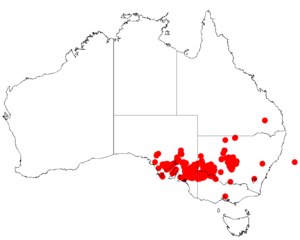Dwarf nealie facts for kids
Quick facts for kids Dwarf Nealie |
|
|---|---|
| Scientific classification | |
| Genus: |
Acacia
|
| Species: |
wilhelmiana
|
 |
|
| Occurrence data from AVH | |
Acacia wilhelmiana, also known as the dwarf nealie, Wilhelmi’s wattle, or mist wattle, is a type of shrub. It belongs to a large group of plants called Acacia, which are often called wattles in Australia. This plant is found in the mallee region of central and eastern Australia.
What Does the Dwarf Nealie Look Like?
The dwarf nealie is a bushy plant that usually grows between 1 and 3 meters (about 3 to 10 feet) tall. It has branches that are a bit sticky (resinous) and can be covered with a few hairs. The tips of its branches often have yellow stripes.
Its leaves, which are actually flattened leaf stems called phyllodes, are green and shaped like narrow lines or ovals. They can be straight or slightly curved. These phyllodes are usually about 1 to 3 centimeters long and 1 to 4 millimeters wide. Each one often has two main veins on its surface.
This plant blooms between August and November, showing off bright yellow flowers. The flowers grow in small, round clusters. Each cluster usually has about 17 to 22 light golden flowers. These flower clusters appear alone or in pairs on short stalks.
After the flowers, the plant forms seed pods. These pods are very curved, sometimes even twisted or coiled. They are about 6 centimeters long and 2 to 3 millimeters wide. Inside these pods are oblong-shaped seeds.
How Was the Dwarf Nealie Named?
The dwarf nealie was first officially described by a botanist named Ferdinand von Mueller in 1855. He included it in his book about rare or new Australian plants.
The plant's scientific name, wilhelmiana, honors Carl Wilhelmi. He used to be in charge of the Royal Botanic Gardens in Melbourne for a time.
The dwarf nealie is part of a special group of Acacia plants. This group includes nine other close relatives. Some of these are Acacia abrupta, Acacia ascendens, Acacia barattensis, Acacia brachypoda, Acacia cowaniana, Acacia gracilifolia, Acacia helmsiana, Acacia leptalea, Acacia menzelii, and Acacia viscifolia.
Where Does the Dwarf Nealie Grow?
The dwarf nealie is a plant that grows naturally only in certain parts of Australia. This is called being endemic. You can find it in the southeastern part of South Australia, central and eastern New South Wales, and northeastern Victoria.
It likes to grow on flat areas and sand dunes. It prefers sandy or loamy soils. This plant is a common part of the "mallee communities." These are special types of bushlands where many eucalyptus trees and other shrubs grow with multiple stems from the ground.

